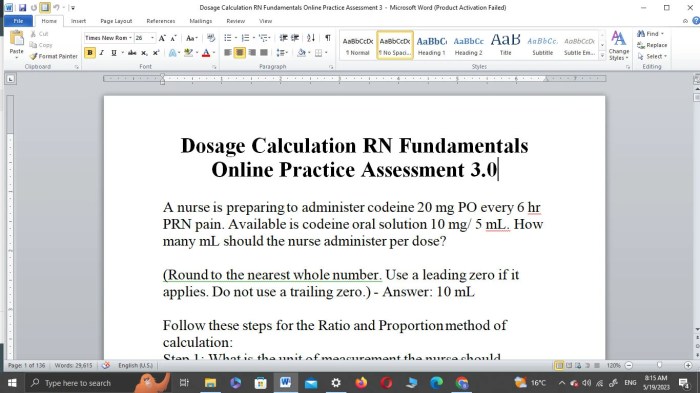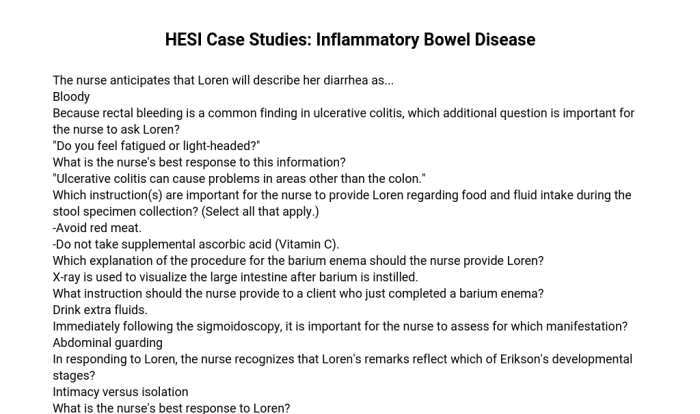Dosage calculation rn fundamentals proctored assessment 3.1 – Dosage Calculation Fundamentals: A Comprehensive Guide for RNs provides an in-depth exploration of the principles, methods, and applications of dosage calculation in nursing practice. This essential guide equips RNs with the knowledge and skills necessary to ensure accurate and safe medication administration.
The guide covers a wide range of topics, including the basic principles of dosage calculation, common dosage calculations used in nursing practice, and the importance of accurate dosage calculation in ensuring patient safety.
Dosage Calculation Fundamentals

Dosage calculation is a critical skill for registered nurses (RNs) to ensure accurate and safe medication administration. It involves the precise determination of the appropriate dosage of medication for a patient based on various factors, including their weight, age, and medical condition.
The basic principles of dosage calculation include:
- Understanding the different units of measurement used in medication administration
- Converting between different units to ensure accurate dosing
- Using appropriate mathematical calculations to determine the correct dosage
Common dosage calculations used in nursing practice include:
- Calculating the total daily dose of a medication
- Determining the frequency and duration of medication administration
- Adjusting dosages based on patient weight or other factors
Accurate dosage calculation is essential for patient safety as it ensures that patients receive the correct amount of medication to achieve the desired therapeutic effect while minimizing the risk of adverse reactions or overdosing.
Proctored Assessment 3.1
Proctored Assessment 3.1 is a standardized assessment designed to evaluate the dosage calculation skills of RNs. It is typically administered by a certified proctor and consists of a series of multiple-choice questions and case studies that require candidates to apply dosage calculation principles to real-world scenarios.
The key concepts and skills tested in Proctored Assessment 3.1 include:
- Converting between different units of measurement
- Calculating dosages using dimensional analysis or ratio-proportion methods
- Adjusting dosages based on patient weight or other factors
- Identifying and correcting medication errors
To prepare for Proctored Assessment 3.1, it is recommended to:
- Review the basic principles of dosage calculation
- Practice solving dosage calculation problems using different methods
- Become familiar with the format and content of the assessment
- Seek support from a tutor or mentor if needed
Dosage Calculation Methods

There are two primary methods used for dosage calculation in nursing practice:
- Dimensional analysis
- Ratio-proportion
Dimensional analysis involves setting up a series of equalities to convert between different units of measurement. For example, to convert 500 mg of a medication to grams, you would set up the following equality:
500 mg = x g
Then, you would use the conversion factor 1 g = 1000 mg to solve for x:
x = 500 mg / 1000 mg/g = 0.5 g
Ratio-proportion involves setting up a proportion between the desired dose and the available dose. For example, if you need to administer 100 mg of a medication and you have a solution that contains 20 mg/mL, you would set up the following proportion:
100 mg / x mL = 20 mg / 1 mL
Then, you would solve for x to determine the volume of solution needed to administer 100 mg of the medication:
x = 100 mg
1 mL / 20 mg = 5 mL
Both dimensional analysis and ratio-proportion are valid methods for dosage calculation. The choice of method depends on the specific problem and the nurse’s preference.
Medication Administration: Dosage Calculation Rn Fundamentals Proctored Assessment 3.1
Medication administration is the process of giving a medication to a patient. There are various routes of medication administration, including:
- Oral
- Intravenous (IV)
- Intramuscular (IM)
- Subcutaneous (SC)
- Topical
The choice of route of administration depends on factors such as the medication’s properties, the patient’s condition, and the desired therapeutic effect.
Safe medication administration requires adherence to the “five rights” of medication administration:
- Right patient
- Right medication
- Right dose
- Right route
- Right time
Patient education and monitoring are also essential aspects of medication administration. Nurses should ensure that patients understand how to take their medications correctly and monitor them for any adverse reactions or side effects.
Case Studies

Case studies provide valuable opportunities to apply dosage calculation and medication administration principles to real-world scenarios. Here is an example of a case study:
A patient weighing 70 kg is prescribed a medication that is available as a 20 mg/mL solution. The desired dose is 100 mg. Calculate the volume of solution needed to administer the medication.
Using dimensional analysis:
100 mg = x mL
20 mg/mL
x = 100 mg / 20 mg/mL = 5 mL
Therefore, 5 mL of the solution is needed to administer the 100 mg dose of the medication.
Case studies can be used to identify common errors in dosage calculation and medication administration, as well as to reinforce the importance of accurate and safe medication practices.
User Queries
What is the purpose of dosage calculation in nursing?
Dosage calculation is essential for determining the appropriate amount of medication to administer to a patient. Accurate dosage calculation ensures that patients receive the correct dose of medication to achieve the desired therapeutic effect while minimizing the risk of adverse reactions.
What are the different methods used for dosage calculation?
There are several methods used for dosage calculation, including dimensional analysis, ratio-proportion, and the formula method. Each method has its own advantages and disadvantages, and the choice of method depends on the specific situation.
What are the key principles of safe medication administration?
The key principles of safe medication administration include the “five rights” of medication administration: right patient, right drug, right dose, right route, and right time. Additionally, nurses must follow proper procedures for medication preparation, storage, and disposal.

